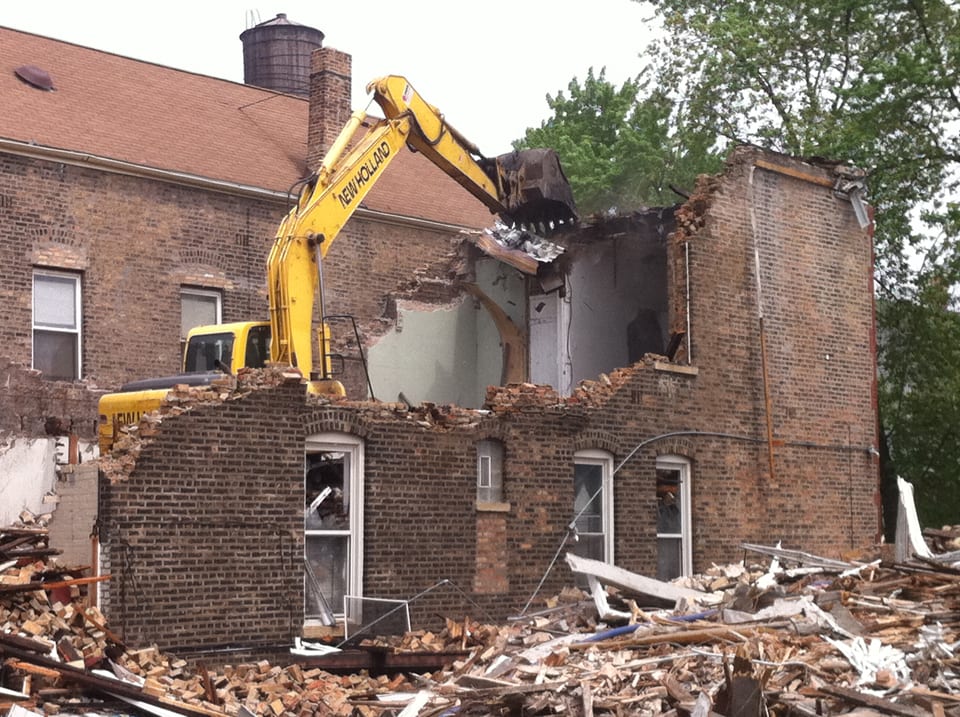What do we lose, when we lose our buildings?
This entry was posted on August 20 2015 by Eric
We have not had to face this question for awhile, but with tentative signs of economic improvement, East Village, Wicker Park and Bucktown are beginning to see rampant tear downs again. In the last six weeks, on Wood Street between Chicago and Armitage alone, no fewer than six vintage brick and stone buildings have been lost. And these are by no means the only ones lost recently.
The 1880's and 1890's era red brick buildings that characterize East Village, Ukrainian Village, Wicker Park and Bucktown are part of our identity as Chicagoans. They are a tangible connection to the boom period that followed the Chicago Fire which Carl Sandburg captured in his famous poem: "...hog butcher for the world, tool maker, stacker of wheat...". Every morning, out of these buildings came those hog butchers, those tool makers and those stackers of wheat. Those men and women, who built the foundations of the world class city we know today, walked our streets, climbed our stairs, ate, slept, lived and died in our homes. What do we lose when we lose our buildings? We lose ourselves.We have not had to face this question for awhile, but with tentative signs of economic improvement, East Village, Wicker Park and Bucktown are beginning to see rampant tear downs again. In the last six weeks, on Wood Street between Chicago and Armitage alone, no fewer than six vintage brick and stone buildings have been lost. And these are by no means the only ones lost recently.
In the roman, medieval and renaissance towns of Europe, demolition of existing buildings is rarely seen. This is not because they are protected by law (though of course some are), but because their cultural value is universally recognized. Buildings connect people to their ancestors over the centuries and millennia; buildings give physical expression to culture; buildings, like other forms of art, grant us immortality. In Europe, destruction of the built environment is tantamount to cultural suicide.
There is no question that American culture is different. It is defined by individualism, self-expression and reinvention, and with a shorter history we tend to look forward more than back. These values make our culture unique and have propelled our country to a position of power and leadership unparalleled in world history. But these values can also be counterproductive; they have created a consumption-based society where "new" is always better, and a culture that too often forgets its history.
Conversations about the value of old buildings are often framed in terms of property rights, but we really need to view the issue in terms of social norms. This is perfectly sensible, since urban living is untenable if everyone insists on exercising their rights at the extremes. Urban dwellers implicitly understand the need for self-restraint, shared responsibility and concern for one-another's well being; it comes with living thirty inches away from one's neighbor.
Shifting the argument away from rights and toward responsibilities will require a sea change in attitudes, but it is not unprecedented. Less than two decades ago, smoking was widespread and seen as a personal right. Today, individuals still have the right to smoke but the framework of "rights" has been turned inside out. Non-smokers also have the right not to breath second-hand smoke. Similarly, we need to acknowledge that individual property rights do not exist in a vacuum; they are counterbalanced with the interests of neighbors and communities.
We can start by considering whether financial "ownership" of a building is a high enough bar to release a property owner from further responsibility to the community, or whether there are social and environmental debts that must be satisfied as well. Is it acceptable to replace a lovely building with a poorly constructed one of inferior design? Can we allow the bricks of an old building to be landfill without acknowledging the environmental damage done 130 years ago in producing them? Can we tolerate the waste of old-growth lumber cut more than a century ago from two hundred year old trees? Can anyone truly "own" the sentimental value of a home to its inhabitants and community over thirteen decades? The full historic, cultural and environmental value of a building is not captured by its purchase price, and until it is, a building cannot truly be "owned."
People come to our historic West Town communities for the synergy of charming architecture, unique businesses, public transportation, lovely parks, and an interesting mix of workers, professionals and artists. When any one of these elements is eroded too much, through gentrification, demolition, economic decline, service cuts or crime, they all suffer. Each lost building pushes us closer to the four decades of neighborhood decline that we've only begun to reverse.
The buildings on Wood Street are gone, but the threat remains. As a community, we must send a clear message to our elected representatives and developers: We value our history, our culture and the environment, and we will not stand by and allow the fabric of our community to be exploited for profit while its very value is diminished.

This entry was posted in , Miscellaneous & Bldg. 51 on August 20 2015 by Eric
WORDLWIDE SHIPPING
If required, please contact an Urban Remains sales associate.
NEW PRODUCTS DAILY
Check back daily as we are constantly adding new products.
PREMIUM SUPPORT
We're here to help answer any question. Contact us anytime!
SALES & PROMOTIONS
Join our newsletter to get the latest information

























